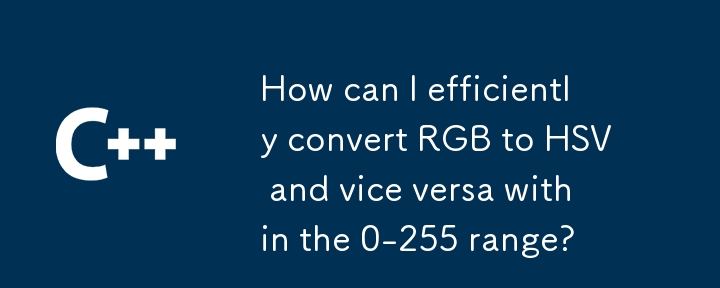Found a total of 10000 related content

How to control the size of XML converted to images?
Article Introduction:To generate images through XML, you need to use graph libraries (such as Pillow and JFreeChart) as bridges to generate images based on metadata (size, color) in XML. The key to controlling the size of the image is to adjust the values ??of the <width> and <height> tags in XML. However, in practical applications, the complexity of XML structure, the fineness of graph drawing, the speed of image generation and memory consumption, and the selection of image formats all have an impact on the generated image size. Therefore, it is necessary to have a deep understanding of XML structure, proficient in the graphics library, and consider factors such as optimization algorithms and image format selection.
2025-04-02
comment 0
613

How Can I Merge Two Images in C#/.NET?
Article Introduction:Merging Images in C#/.NET: A Practical ExampleYou have two images, a 500x500 transparent image and a 150x150 image, which you want to merge into a...
2025-01-04
comment 0
617

Experience in participating in VSCode offline technology exchange activities
Article Introduction:I have a lot of experience in participating in VSCode offline technology exchange activities, and my main gains include sharing of plug-in development, practical demonstrations and communication with other developers. 1. Sharing of plug-in development: I learned how to use VSCode's plug-in API to improve development efficiency, such as automatic formatting and static analysis plug-ins. 2. Practical demonstration: I learned how to use VSCode for remote development and realized its flexibility and scalability. 3. Communicate with developers: I have obtained skills to optimize VSCode startup speed, such as reducing the number of plug-ins loaded at startup and managing the plug-in loading order. In short, this event has benefited me a lot and I highly recommend those who are interested in VSCode to participate.
2025-05-29
comment 0
814

Getting started with a beginner in ps photo editing tutorial_Basic knowledge of ps photo editing tutorial
Article Introduction:Mastering the basics is a must-have for beginners in Adobe Photoshop, including: Lasso and Masks: Manage image elements and specify visibility selection tools: lasso, magic wand, quick selection, for precise selection of area adjustments and tools: Brightness/Contrast, Curves, Stain Repair Brush Image Optimization: Crop, Sharpen, Noise Reduction File Format: JPEG (Web), PNG (Transparency), TIFF (High Quality) Shortcut Keys: Undo, Copy, Paste
2025-04-06
comment 0
1110


jQuery PNG/JPEG/GIF Plugins
Article Introduction:A series of jQuery PNG/JPEG/GIF plug-ins to achieve image animation, cartoon background and other effects, helping you to take the web image design to the next level! Related blog posts:
100 jQuery pictures/content sliders
jQuery PNG repair IE6 background image
jQuery Canimate plugin
A jQuery plug-in that uses high-speed printing of image files to achieve animation effects of non-GIF image files. You can easily change the frame rate; in addition, you can still do everything on elements that contain the image (such as adding borders).
Source Code Demo PNGFix jQuery Plug-in
By applying IE-specific filters to images with alpha channels, I allow
2025-02-27
comment 0
750

10 Popular Plugins to Extend or Enhance Your WordPress Site
Article Introduction:A practical plug-in guide to improving the functionality of WordPress websites
Key points:
WordPress plug-in can efficiently improve website functions, covering SEO tools, appointment systems, content personalization and social media automation.
Plugin selection depends on the specific needs of the website, but some plugins such as wpDataTables, Amelia, NextGEN Gallery, Rank Math SEO, and Logic Hop are powerful and suitable for a variety of scenarios.
Using plugins not only saves time and effort, it also expands website features, improves user experience, and may improve site performance and ranking.
This sponsored post was created by our content partner BAW Media. Thanks you
2025-02-08
comment 0
1225

How to encapsulate functions in vue
Article Introduction:There are three ways to encapsulate functions in Vue: 1. Use mixins to define functions in mixin files and use mixin options in components; 2. Use plug-ins to add functions to Vue prototypes and install plug-ins through install methods; 3. Use global methods to add functions to Vue prototypes through plug-ins. The selection method depends on project requirements and preferences.
2025-04-08
comment 0
844

How to use the magic wand tool in Photoshop
Article Introduction:Use Photoshop's magic wand tool to quickly select areas of similar colors, suitable for background deletion and simple cutouts. The core is to master the setting options and use them in conjunction with other functions. The operation steps are as follows: 1. Press the shortcut key W to select the magic wand tool, click the image area to select the area; 2. Press Shift to add the selection, Alt or Option to subtract the selection; 3. Adjust the "Tolerance" value to control the selection range, the smaller the value, the more accurate it is; 4. Check "Continuous" to select only the connected areas, cancel the entire image to select the entire image; 5. Enable "Sample all layers" to select the color based on the overall effect of multiple layers. Magic wands are suitable for scenes with single colors and obvious contrast, and are not suitable for situations where colors are similar, edges are blurred or require high precision. Practical techniques include scaling canvas, combining "select"
2025-07-21
comment 0
499


Image Processing Using?Python
Article Introduction:Image processing with Python's scikit-image library: A practical guide
A 1911 newspaper editor famously stated, "Use a picture. It's worth a thousand words." This highlights the crucial role images play in communication, from everyday phot
2025-03-03
comment 0
982

What are some lesser-known but useful features of Sublime Text?
Article Introduction:SublimeText has many practical but easily overlooked features. 1. Multiple selection and quick editing: supports multi-cursor operation, splitting and selecting rows, batch modifying the same words to improve the efficiency of processing duplicate content; 2. Fuzzy search expansion function: can jump function definition, specify line number, and global search symbols to facilitate navigation of large projects; 3. Automatic saving and project recovery: no manual saving, it can automatically recover after crash, retaining the multi-task working state; 4. Custom shortcut keys and plug-in extensions: Install plug-ins and custom shortcut keys through the command panel to significantly improve personalized editing efficiency.
2025-07-08
comment 0
686

8 jQuery 360 Degrees Image Display Plugins
Article Introduction:Use jQuery plug-in to easily create a 360-degree panoramic image display effect! No Flash is required, just JavaScript and jQuery to achieve a 360-degree view of objects or attractions from all angles. Most plug-ins require 36 images to form a panoramic view, and after preparing the pictures, it is very easy to operate. Related recommendations: - 30 text overlay image plug-ins - 30 unique jQuery image sliders - jQuery image parallax demonstration
Reel 1.1.3
This is a jQuery plugin that converts image tags into dynamic "projections" of pre-built animated frame sequences, designed to provide a 360° view of the object. It is widely used in Flash and Java
2025-03-02
comment 0
853

How to optimize large WordPress sites
Article Introduction:Optimizing large WordPress websites requires starting from four aspects: database, caching, image management and plug-in control. 1. Database optimization: Regularly clean redundant data, use cache, split table structure and optimize indexes to improve query efficiency; 2. Efficient caching strategy: combine page cache, object cache and CDN acceleration to reasonably set cache expiration time; 3. Image management: compress pictures, adopt WebP format, enable delayed loading, and consider external storage to reduce server pressure; 4. Plug-in control: streamline the number of plug-ins, select high-quality plug-ins, and regularly evaluate performance impact, and use code to replace plug-in functions if necessary.
2025-07-23
comment 0
126

How do I create custom brushes in Photoshop?
Article Introduction:The article discusses creating and using custom brushes in Photoshop, detailing steps from image selection to brush customization and sharing. It emphasizes techniques for effective brush design and creative applications in projects.
2025-03-13
comment 0
859

Integrating Large Language Models in Production Applications
Article Introduction:In this practical guide, you will learn how to create a highly scalable model deployment solution with built-in LLMs for your applications.
In your examples, we will use Hugging Face’s ChatGPT2 model, but you can easily plug in any other model inclu
2025-01-07
comment 0
1059

How to use PostCSS
Article Introduction:PostCSS is a tool for converting CSS through JavaScript plug-in, and its functionality depends entirely on the selection and configuration of the plug-in. 1. It can automatically complete CSS optimization, compatibility processing and syntax extension; 2. Common plug-ins include autoprefixer, postcss-preset-env, cssnano, postcss-import and postcss-nested; 3. When used with the project, most modern frameworks have integrated support, just add postcss.config.js configuration file; 4. Pay attention to details such as browserslist configuration, environment distinction and plug-in order.
2025-07-03
comment 0
179

Using Photoshop: Creative Possibilities and Practical Uses
Article Introduction:Photoshop is very practical and creative in practical applications. 1) It provides basic editing, repairing and synthesis functions, suitable for beginners and professionals. 2) Advanced features such as content recognition fill and layer style can improve image effects. 3) Mastering shortcut keys and optimizing layer structure can improve work efficiency.
2025-04-22
comment 0
1313

Extending OctoberCMS - Building a Soft-Delete Plugin
Article Introduction:OctoberCMS: In-depth exploration of plug-in expansion and practical combat of soft delete plug-in
Developers generally prefer easy-to-use and scalable CMS. OctoberCMS adheres to the concept of simplicity first, bringing a pleasant experience to developers and users. This article demonstrates some of the extensible features of OctoberCMS and extends the functionality of another plug-in with a simple plug-in.
Key Points
OctoberCMS provides a simple and easy-to-use CMS while allowing extensions through plug-ins. This scalability is reflected in the extent to which developers can penetrate the internal mechanisms of CMS, including modifying the functions of other developers plug-ins.
The Rainlab Blog plugin allows articles to be created and assigned to different categories.
2025-02-10
comment 0
1210



















